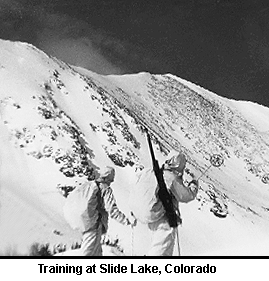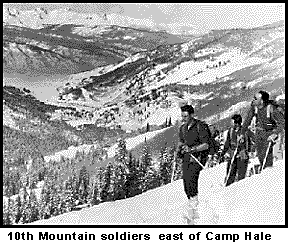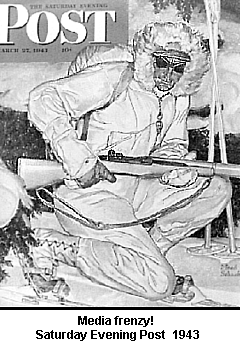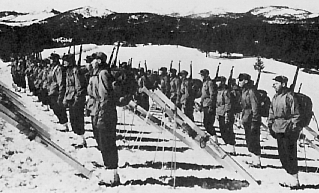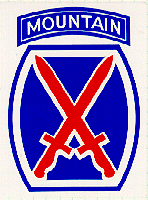10th Mountain Division History
By Lou Dawson
During the Russian-Finnish war in winter of 1939-40, Finnish ski troops used skis and guerrilla raids to bring the Russians to their knees. The Russians rallied in the spring and won the conflict. But the world took notice of the Finn’s keen resistance, when they used their winter skills — including skis — to great advantage.
Charles Minot “Minnie” Dole (founder of the National Ski Patrol, U.S.) was one American who saw the importance of what the Finns had done. Dole formulated a plan to form American ski troops and went to Washington with his idea, where it was treated with “polite derision,” as Dole later stated. He persisted in presenting his idea, however, and eventually found a sympathetic ear in Chief of Staff General George Marshall. Meanwhile, in the Balkans, invading Italians had been driven into the mountains by the Greeks. Winter hit. More than 10,000 Italians died of exposure (in addition to 25,000 battle deaths). This was a military disaster, and the US Army took notice.
As a result of Dole’s persistence and the Balkans debacle, on November 15, 1941, the 87th Mountain Regiment was created to specialize in mountain and cold weather warfare. The tyro infantry began training at Fort Lewis, Washington. To begin, winter training was mandated for picked men from various divisions. Dole was frustrated, however: due to the military bureaucracy, many ideal candidates were still being sent to other divisions. Dole took action and assigned his assistant to ply a key General’s female staffer with a three martini lunch. Soon after, Dole had a mandate to recruit for the new regiment. Incidentally, this was the first time in the US that a non-government entity did military recruiting.
It was hard to find men for the new regiment. Right off, the recruiting method gave the impression that this was no ordinary group of soldiers. For example, three reference letters were required. Moreover, many famous skiers and climbers signed up; where the stars led, others followed. Many ivy leaguers and “non-army” types joined out of a mistaken notion that it would be easy — at least elite — duty.
As a result of the recruiting effort, the new regiment had the highest percentage of college educated men ever assembled in one division, and the intelligence level was so great that more than two-thirds of the soldiers would qualify as officers. Even a former assistant of Albert Einstein was recruited, and huddled over math problems in the evening. Not only were the troops bright and many of them well educated, but the level of outdoorsmanship was extremely high, with many men joining who already had the requisite backcountry survival skills.
Elite duty; but not easy. “We climb to conquer,” was the new regiment’s motto, and their training was designed to make this a reality. While at Fort Lewis, the new troops did a rare (but not the first) winter ascent of Mount Rainier under the leadership of Corporal Peter Gabriel, a famous Swiss mountaineer who had recently immigrated and been head of a ski school in New Hampshire. During the Rainier ascent the hard-men carried 85 pound packs. The troops rounded off their stint in the Northwest with numerous trips near Mount Rainier, and several trips into the Olympic Mountains, including a 40 mile west/east crossing of the Olympics.
On December 6, 1942, the 87th moved lock-stock-and-barrel to Camp Hale, a location high in the Colorado Rocky Mountains
As a result of the successful training at Fort Lewis, the War Department had decided that mountain troops would be a part of the U. S. Army, and they began a search for a training camp site. The top location, West Yellowstone Montana, was ruled out because of nearby trumpeter swans. A high mountain valley near Aspen (Castle Creek, Ashcroft townsite) was considered, but there was not enough space for 15,000 men! Finally, a site was chosen at 9,200 feet in the Eagle River valley in the Colorado Rockies, near a railroad siding called Pando, just to the north of Tennessee Pass (near Leadville). It was named Camp Hale, after General Irving Hale from Denver.
To build Camp Hale, the army sent in thousands of construction workers. The “Pando Constructors” graded three miles of the valley as flat as a golf course and channeled the river into a straight ditch. With the nearby mountains, cliffs, and rivers, in many ways it was an ideal spot to train mountain troops. Camp Hale was completed November 16, 1942, and more than 11,000 troops moved in three weeks later. Presently, the flats of Camp Hale are still obvious at the site, as are the many foundations of what were innumerable buildings, warehouses and meeting halls.
Life at the camp had a severe downside. Thousands of lowlanders were tormented by the altitude. A pall of coal smog hung over the valley, causing a chronic cough known as the Pando hack (after nearby Pando). In winter, the temperature hovered below zero for days, while strenuous drills never stopped. In the spring, the camp was a sea of mud. Recreation was problematic. Leadville, the nearby town and a former mining center with plentiful recreation for single men, was placed off limits because of prevalent prostitution (the town was opened back up a few months before the soldiers left Camp Hale). It was a nine-hour expensive trip to Denver by train. The clubs at Hale only served watery beer. Many of the soldiers called it “Camp Hell,” and wags were fond of saying, “Anyone who transfers to combat from the mountain troops is yellow!”
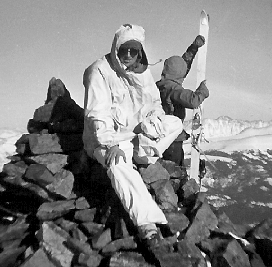
Photo taken by Lieutenant Landry (pioneer extreme skier Chris Landry's father) atop Homestake Peak, Colorado, 1943.
The training was endless and harsh; but iron sharpens iron. Out of “Camp Hell” marched one of the most competent divisions in modern warfare. In fact, in our research here at WildSnow.com we found reference to German general saying that the 10th was the finest division he had ever faced.
Aside from days of rock-climbing, alpine travel, and weapons practice, the winter training was what really set the mountain troops apart. In the two years at Camp Hale, two major maneuvers were carried out on Homestake Peak (near the 10th Mountain Division Hut) and in other mountains surrounding the camp, such as the Resolution Creek area. The first was a disaster that came to be known by some as the “retreat from Moscow.” Some soldiers deliberately froze their feet to get out of the hills. One trooper exclaimed, “I’d damn well rather have frostbite than stay up in this hell.” Fortunately, with better planning and training, the next winter the men redeemed themselves in an exemplary training action in the same terrain.
For those with previous ski experience, the ski training at Camp Hale was casual, if not fun. Yet for those new to the planks, it could be harsh. The southern recruits called their skis, “mah to-chuah (torture) boards,” and one Sergeant Major ceremoniously chopped up his skis and burnt the pieces in a fire. Perhaps the epitome of klutzy ski training was the Manual of Skis, a series of ceremonious movements meant to replace the well known rifle acrobatics of the Manual of Arms. Problem was, long skis were a little harder to handle than a rifle, and the heavy windmilling planks were dangerous to those who made the mistake of standing near a soldier who was “presenting skis.”
The first campaign of the mountain troops was the tragic invasion of Kiska in the Aleutian Islands. A chapter of World War II that exemplifies the folly of war, the Kiska invasion came about because the Japanese decided on a strategic occupation of these windlashed, arctic hunks of real estate, and the United States could not abide such aggression.
The leadup to Kiska occurred when things got out of hand during the 7th Infantry’s taking of Attu Island from the Japanese, but the island almost taking them in the process. During the Attu campaign, more than 12,000 men succumbed to trenchfoot alone. It was clear that men trained for the cold and wet were needed, so the 87th Mountain was selected as the invasion force for the second Japanese occupied Aleutian island: Kiska.
A huge operation ensued. The mountain troops had yet to see real battle, but they were primed. They were first moved to Fort Ord, California, for amphibious training. Equipped with the latest wet and cold weather gear and transported by more than 100 ships, they left San Francisco on July 27, 1943.
On August 15, under the cover of morning darkness they made a beach landing on Kiska. Soon, their first fighting — battalion headquarters was under attack! More shots — men dying — then nightfall. The next day, the men realized that they had been fighting each other. Finally, after days of fear and misery, it was discovered that the Japanese had left before the invasion!
With few losses considering the confusion and weather of Kiska, the 87th returned to Camp Hale in December of 1943. It was during that winter that 33 troopers made the legendary 4-day “Trooper” ski traverse from Leadville to Aspen (in February of 1944), and successful training was done in the surrounding terrain by the now hardened troops.
Yet all was not powder snow twinkling in a rosy sunrise, and morale continued at a low ebb. Persistent rumors held that the well trained soldiers would never see battle. The last straw was when, on June 22, 1944, the men were moved from Camp Hale to Camp Swift, Texas, to take part in maneuvers. Suddenly they were learning how to handle 4,000 mules, and rappelling off buildings to break the boredom. Something had to give. It did.
General George Hays, a true military leader with a WW1 Congressional Medal of Honor, was given command of the men. Morale was still low when Hays took charge. But by intensely training the men as a group, he made them into a proud and hardened army. Finally, on November 7, 1944, the outfit officially became the 10th Mountain Division.
With the debacle of Kiska behind them, their new status as a Division, awesome training, and inspiring leadership, the men were ready for real warfare.
By January of 1945, the 10th was in Italy. The Germans had taken the Italian high ground and established positions in the Apennine mountains to guard the route to the Po Valley. It was the 10th’s job to take the high ground back, and take it they did. Using ropes and the cover of darkness, the Division’s rock specialists climbed the 1,200 foot rock face of Manicinello – Campiano Ridge (A.K.A. Riva Ridge), and on the morning of February 19, 1945, the soldiers of the 10th took the Germans on top of Campiano Peak in a devastating surprise attack.
The troops again engaged the Germans in the Battle of Mount Belvedere. This was the big one — the battle to gain the upper hand. The 10th had the summit in 24 hours, and the Division’s engineers even built an aerial tramway to move material, and evacuate wounded from the summit. The 10th went on to participate in the Po River offensive and were the first of the allied forces to reach and cross the Po River. Losses were heavy; 990 soldiers gave their lives while fighting in Italy (and during Kiska). In the end, the 10th had gained a reputation as one of the toughest and most competent groups of soldiers to fight in World War II.
While skis were never used in combat by the 10th Mountain Division, they were use for patrols before the Riva Ridge operation, and at least one of those patrols participated in a brief gun battle after removing their skis and proceeding on foot.
Hardship aside (or perhaps because of it), the men of the 10th developed a strong camaraderie, and many of them gained or at least reinforced a great love for skiing, mountains, and Colorado. After the war, hundreds of 10th veterans returned to Colorado to settle down, had a huge influence on the culture that we enjoy here at WildSnow.com.
But you think all those 10th Vets came back and climbed mountains? Not all. One veteran jokingly stated to me during my research that the one thing he learned in the army, “was to never ski uphill on skis again.” Perhaps that’s why many 10th Vets went on to become involved in the post-war ski resort boom, during which many of the nation’s ski lifts were built. Yet aside from ski resorts, many 10th veterans, with their ski skills, knowledge of the land, and enthusiasm, went on to become key figures in the development of the United States’ mountaineering tradition both in skiing and climbing.
10th Mountain veteran Fritz Benedict founded the 10th Mountain Division Memorial Hut System. Veteran Bil Dunaway made the first ski descent of Mount Blanc in Franc, then settled in Aspen Colorado for a long career of as a newspaperman and prolific mountaineer. Ski racer Toni Matt was a vet, as was Dartmouth coach Walter Prager and Aspen ski pioneer Friedl Pfeifer. Paul Petzoldt, famous mountaineer and founder of the National Outdoor Leadership School, was also a recruit. California ski pioneers Hans George, Ed Heath and Wally McPherson are also 10th Mountain veterans.
The 10th Mountain Division was deactivated in 1945. In 1985, a new 10th Mountain Division was organized at Camp Drum, New York. The original “10th” is memorialized by monuments at Camp Hale and at the summit of Tennessee Pass on Colorado Highway 24.
No doubt, the saga of the 10th Mountain “ski troops” contributed more to the legitimacy of ski mountaineering in the United States than any other event. A popular (yet apocryphal) anecdote of the day sums up the public’s acceptance of the troops and their ilk: A trooper is on maneuvers atop 13,209-foot Homestake Peak. He picks up the radio voice of a pilot landing at Peterson AFB in Denver. “Am at 11,000 feet, coming in for a landing, gliding gliding gliding,” said the pilot. The trooper keys his mike and says “This is Private —— of the mountain troops, am at 12,000 feet, walking walking walking.”
